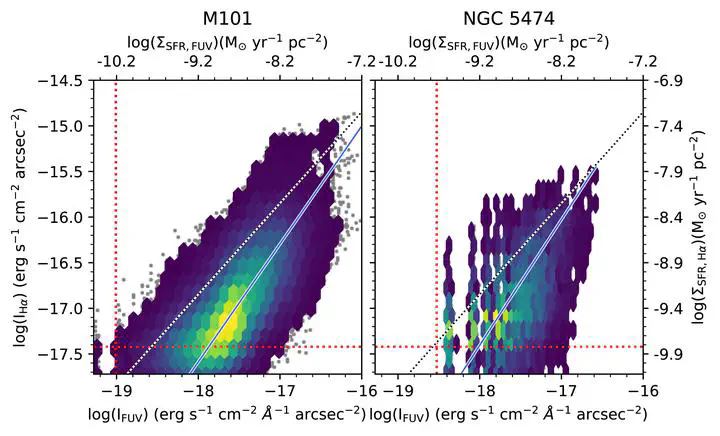Implications on star formation rate indicators from H II regions and diffuse ionized gas in the M101 Group
 Image credit: Figure 7 of Watkins et al. (2024)
Image credit: Figure 7 of Watkins et al. (2024)Abstract
We examine the connection between diffuse ionized gas (DIG), H II regions, and field O and B stars in the nearby spiral M101 and its dwarf companion NGC 5474 using ultra-deep Hα narrow-band imaging and archival GALEX UV imaging. We find a strong connection between DIG Hα surface brightness and the incident ionizing flux leaked from the nearby H II regions, which we reproduce well using simple CLOUDY simulations. While we also find a strong correlation between Hα and co-spatial far-ultraviolet (FUV) surface brightness in DIG, the extinction-corrected integrated UV colours in these regions imply stellar populations too old to produce the necessary ionizing photon flux. Combined, this suggests that H II region leakage, not field OB stars, is the primary source of DIG in the M101 Group. Corroborating this interpretation, we find systematic disagreement between the Hα- and FUV-derived star formation rates (SFRs) in the DIG, with $\text{SFR}_{\text{H}\alpha} < \text{SFR}_{\text{FUV}}$ everywhere. Within H II regions, we find a constant SFR ratio of 0.44 to a limit of ~$10^{-5}$ $\text{M}_\odot$ $\text{yr}^{-1}$. This result is in tension with other studies of star formation in spiral galaxies, which typically show a declining $\text{SFR}_{\text{H}\alpha}/\text{SFR}_{\text{FUV}}$ ratio at low SFR. We reproduce such trends only when considering spatially averaged photometry that mixes H II regions, DIG, and regions lacking Hα entirely, suggesting that the declining trends found in other galaxies may result purely from the relative fraction of diffuse flux, leaky compact H II regions, and non-ionizing FUV-emitting stellar populations in different regions within the galaxy.